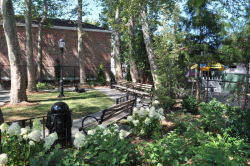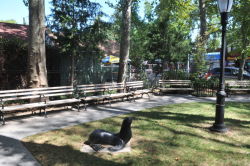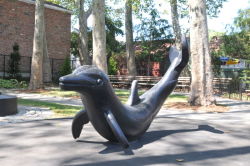Hawkins Park
Hawkins Park
This park honors United States Navy Seaman Second Class and City Island native Leonard Hillson Hawkins who died while serving on the U.S.S. Delaware in World War I. Hawkins was serving on the battleship Delaware while it protected American interests in Mexico during 1914 and 1915, and later when it managed to evade torpedoes during two submarine attacks while escorting merchant vessels to Norway in February of 1918. The Delaware protected two more convoys during March and April of that year, but during the trip home Hawkins died of cerebrospinal fever (spinal meningitis) on July 26, 1918. Four days later, the Delaware arrived at Hampton Roads, Virginia.
A granite monument with a bronze plaque in Hawkins Park now honors Hawkins and 104 young men from City Island who served in World War I. The Bronx American Legion Post number 156 is named after Hawkins, and its women’s auxiliary was responsible for the monument’s construction.
Hawkins Street, which runs parallel to the park, was originally Orchard Street. It was renamed by local law in 1950 for the Hawkins family, which has lived on City Island since 1784. The family won renown on the high seas when Captain Elnathan Hawkins became the first man to bring the flowering quince, which is now used in fruit preserves, back from Asia in 1811. The Columbia, which competed in the 1899 and 1901 America’s Cup yacht races, is moored at the Hawkins Shipyard.
City Island is located in the northeastern Bronx and measures one and three-fourths miles at its longest point. At first, the island was referred to variously as Mulberry, Minniffers, Minneford’s and Minnewits. In 1761, Benjamin Palmer purchased the island and planned to build a city on his new property that could rival Manhattan commercially. The island was renamed New City Island around 1800, when the shipbuilding and oyster businesses developed. Later in the 19th century, the community chose to shorten the name to City Island, and in 1896 they voted to detach themselves from Westchester and become part of New York City. During World War II, landing vehicles such as those used in the D-Day invasion of Normandy were manufactured on City Island. Though it is connected to the mainland Bronx by a bridge in its northern part, its distance from the mainland has allowed it to keep a distinctly New England flavor.
Hawkins Park was first acquired by the city as a school site in 1860. In 1900, it was transferred to the Police Department, and in 1933, Parks obtained the property. Two small seal sculptures and one large whale climbing sculpture, stand in tribute to the maritime tradition of the island. There is hexagonal block pavement, lampposts, and planted areas. The park features Chrystie-Forsyth benches, and is surrounded by wrought iron fencing. London plane trees (Plantus x acerifolia) encircle this park, creating welcoming shade above the benches.
Check out your park's Vital Signs
Clean & Safe
Green & Resilient
Empowered & Engaged Users
Share your feedback or learn more about how this park is part of a
Vital Park System



